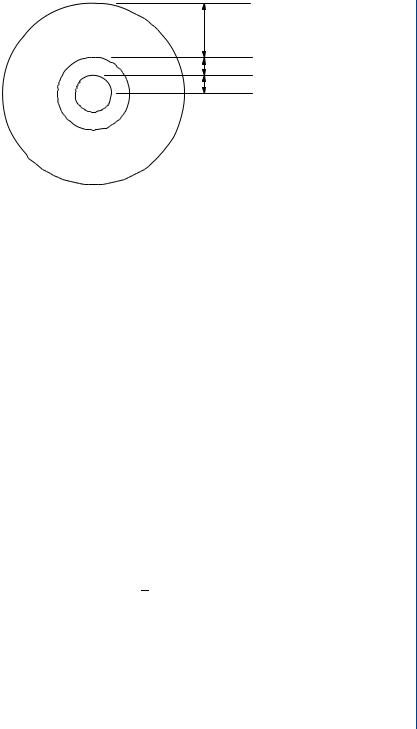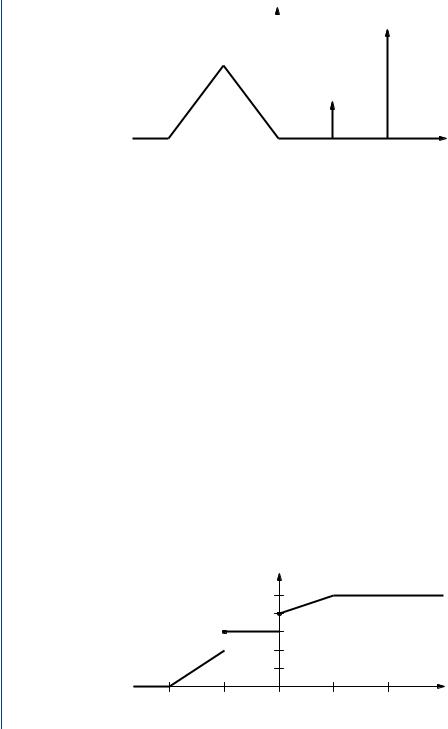
Basic Probability Theory for Biomedical Engineers - JohnD. Enderle
.pdf
|
RANDOM VARIABLES 121 |
1 |
3 in. |
50 |
1 in. |
100 |
1 in. |
|
FIGURE 2.12: Target for Problem 2.31 |
|
27. Random variable y has the PMF |
|
1/8, |
α = 0 |
3/16, |
α = 1 |
py (α) = 1/4, |
α = 2 |
5/16, |
α = 3 |
1/8, |
α = 4. |
Random variable w = (y − 2)2 and event A = {y ≥ 2}. Determine: (a) py| A(α| A),
(b)pw(α).
28.Suppose x is a random variable with
px |
(α) |
= |
βγ α , α = 0, 1, 2, . . . |
|
|
0, |
otherwise. |
||
where β and γ are constants, and 0 < γ < 1. As a function of γ , determine: (a) β,
(b) Fx (α), (c) Fx|x≤x0 (x0/2|x ≤ x0).
29.The time before failure, t, for a certain television set is a random variable with
ft (to ) = 15 e −to /5u(to ).
Event A = {t > 5} and B = {3 < t < 7}. Determine: (a) Ft| A(to | A), (b) ft|B (to |B),
(c) P (B), (d) P (A|B), (e) ft| Ac ∩Bc (to | Ac ∩ Bc ), (f ) P (Ac ∩ B).
30.A random variable x has CDF
Fx (α) = |
|
1 |
|
|
1 |
|
1 |
|
1 |
|
1 |
|
|
||||
α + |
|
u |
α + |
|
|
− αu(α) + |
|
αu(α − 1) |
+ |
|
|
− |
|
|
α |
u (α − 2) , |
|
2 |
2 |
4 |
2 |
4 |
|||||||||||||

122 BASIC PROBABILITY THEORY FOR BIOMEDICAL ENGINEERS
|
|
|
|
0.3 |
|
fx (α ) |
|
|
(0.3) |
|
|
|
|
|
|
|
|
|
|
||||
|
|
|
|
|
|
|
|
|
|
||
|
|
|
|
|
|
|
|
|
|
||
|
|
|
|
0.2 |
|
|
|
|
|
|
|
|
|
|
|
|
|
|
|
|
|
|
|
|
|
|
|
0.1 |
|
|
|
(0.1) |
|
|
|
|
|
|
|
|
|
|
|
|
|
||
|
|
|
|
|
|
|
|
|
|
|
|
|
|
|
|
|
|
|
|
|
|
|
|
−6 |
−3 |
0 |
3 |
6 |
α |
||||||
FIGURE 2.13: Probability density function for Problem 2.37
and event A = {x ≥ 1}. Find: (a) fx (α), (b) P (0.5 < x ≤ 1.5), (c) Fx| A(α| A),
(d)fx| A(α| A).
31.Judge Rawson, the hanging judge, does not treat criminals lightly. However, she does offer a pretrial sentence (in years) based on the outcome of a dart thrown at the target illustrated in Fig. 2.12.
What the defendants do not know is that Judge Rawson is an incredibly accurate dart thrower. The probability of x years of sentence is the ratio of the area of the band marked (100 − x) to the total target area.
Determine: (a) the PMF for the sentence length from a dart throw.
Three defendants choose dart sentences. Determine the probability that: (b) none of the defendants serve time; (c) exactly two of the defendants serve time; (d) each defendant is given a unique sentence.
32.The head football coach at the renowned Fargo Polytechnic Institute is in serious trouble. His job security is directly related to the number of football games the team wins each year. The team has lost its first three games in the eight game schedule. The coach knows that if the team loses five games, he will be fired immediately. The alumni
|
|
|
Fx (α ) |
|
|
|
|
1 |
|
|
|
|
|
|
0.6 |
|
|
−4 |
−2 |
0 |
2 |
4 |
α |
FIGURE 2.14: Cumulative distribution function for Problem 2.38

RANDOM VARIABLES 123
hate losing and consider a tie as bad as a loss. Let x be a random variable whose value equals the number of games the present head coach wins. Assume the probability of winning any game is 0.6 and independent of the results of other games. Determine: (a) px (·), (b) Fx (·), (c) px|x>3(α|x > 3).
33.Consider Problem 32. The team loves the head coach and does not want to lose him. The more desperate the situation becomes for the coach, the better the team plays. Assume the probability the team wins a game is dependent on the total number of losses as P (W|L) = 0.2L, where W is the event the team wins a game and L is the total number of losses for the team. Let A be the event the present head coach is fired before the last game of the season. Determine: (a) px (·), (b) Fx (·), (c) px| A(α| A).
34.A class contains five students of about equal ability. The probability a student obtains an A is 1/5, a B is 2/5, and a C is 2/5. Let the random variable x denote the number of students who earn an A in the class. Determine the PMF for the RV x.
35.Professor Rensselaer has been known to make an occassional blunder during a lecture. The probability that any one student recognizes the blunder and brings it to the attention of the class is 0.13. Assume that the behavior of each student is independent of the behavior of other students. Determine the minimum number of students in the class to insure the probability that a blunder is corrected is at least 0.98.
36.Consider Problem 35. Suppose there are four students in the class. Determine the probability that (a) exactly two students recognize a blunder; (b) exactly one student recognizes each of three blunders; (c) the same student recognizes each of three blunders;
(d)two students recognize the first blunder, one student recognizes the second blunder and no students recognize the third blunder.
37.Random variable x has PDF shown in Fig. 2.13. Event A = {x : −3 < x < 6}. Find:
(a)Fx , (b) P (−5 < x ≤ 3), (c) Fx| A(α| A), (d) fx| A(α| A).
38.Random variable x has CDF shown in Fig. 2.14. Event A = {x : −2 ≤ x < 4}. Find:
(a)fx , (b) P (−2 ≤ x < 1), (c) Fx| A(α| A), (d) fx| A(α| A).

125
Bibliography
[1]M. Abramowitz and I. A. Stegun, editors. Handbook of Mathematical Functions. Dover, New York, 1964.
[2]E. Ackerman and L. C. Gatewood, Mathematical Models in the Health Sciences: A Computer-Aided Approach. University of Minnesota Press, Minneapolis, MN, 1979.
[3]E. Allman and J. Rhodes, Mathematical Models in Biology. Cambridge University Press, Cambridge, UK, 2004.
[4]C. W. Burrill. Measure, Integration, and Probability. McGraw-Hill, New York, 1972.
[5]K. L. Chung. A Course in Probability. Academic Press, New York, 1974.
[6]G. R. Cooper and C. D. McGillem. Probabilistic Methods of Signal and System Analysis. Holt, Rinehart and Winston, New York, second edition, 1986.
[7]Wilbur B. Davenport, Jr. and William L. Root. An Introduction to the Theory of Random Signals and Noise. McGraw-Hill, New York, 1958.
[8]J. L. Doob. Stochastic Processes. John Wiley and Sons, New York, 1953.
[9]A. W. Drake. Fundamentals of Applied Probability Theory. McGraw-Hill, New York, 1967.
[10]J. D. Enderle, S. M. Blanchard, and J. D. Bronzino. Introduction to Biomedical Engineering. Elsevier, Amsterdam, second edition, 2005, 1118 pp.
[11]William Feller. An Introduction to Probability Theory and its Applications. John Wiley and Sons, New York, third edition, 1968.
[12]B. V. Gnedenko and A. N. Kolmogorov. Limit Distributions for Sums of Independent Random Variables. Addison-Wesley, Reading, MA, 1968.
[13]R. M. Gray and L. D. Davisson. RANDOM PROCESSES: A Mathematical Approach for Engineers. Prentice-Hall, Englewood Cliffs, New Jersey, 1986.
[14]C. W. Helstrom. Probability and Stochastic Processes for Engineers. Macmillan, New York, second edition, 1991.
[15]R. C. Hoppensteadt and C. S. Peskin. Mathematics in Medicine and the Life Sciences.
Springer-Verlag, New York, 1992.
[16]J. Keener and J. Sneyd. Mathematical Physiology. Springer, New York, 1998.
[17]P. S. Maybeck. Stochastic Models, Estimation, and Control, volume 1. Academic Press, New York, 1979.

126BASIC PROBABILITY THEORY FOR BIOMEDICAL ENGINEERS
[18]P. S. Maybeck. Stochastic Models, Estimation, and Control, volume 2. Academic Press, New York, 1982.
[19]J. L. Melsa and D. L. Cohn. Decision and Estimation Theory. McGraw-Hill, New York, 1978.
[20]K. S. Miller. COMPLEX STOCHASTIC PROCESSES: An Introduction to Theory and Application. Addison-Wesley, Reading, MA, 1974.
[21]L. Pachter and B. Sturmfels, editors. Algebraic Statistics for Computational Biology. Cambridge University Press, 2005.
[22]A. Papoulis. Probability, Random Variables, and Stochastic Processes. McGraw-Hill, New York, second edition, 1984.
[23]P. Z. Peebles Jr., Probability, Random Variables, and Random Signal Principles. McGrawHill, New York, second edition, 1987.
[24]Yu. A. Rozanov, Stationary Random Processes. Holden-Day, San Francisco, 1967.
[25]K. S. Shanmugan and A. M. Breipohl, RANDOM SIGNALS: Detection, Estimation and Data Analysis. John Wiley and Sons, New York, 1988.
[26]Henry Stark and John W. Woods. Probability, Random Processes, and Estimation Theory for Engineers. Prentice-Hall, Englewood Cliffs, NJ, 1986.
[27]G. van Belle, L. D. Fisher, P. J. Heagerty, and Thomas Lumley, Biostatistics: A Methodology for the Health Sciences. John Wiley and Sons, NJ, 1004.
[28]H. L. Van Trees. Detection, Estimation, and Modulation Theory. John Wiley and Sons, New York, 1968.
[29]L. A. Wainstein and V. D. Zubakov. Extraction of Signals from Noise. Dover, New York, 1962.
[30]E. Wong. Stochastic Processes in Information and Dynamical Systems. McGraw-Hill, New York, 1971.
[31]M. Yaglom. An Introduction to the Theory of Stationary Random Functions. Prentice-Hall, Englewood Cliffs, NJ, 1962.
